 Wat Phra Singh Woramahawihan, Chiang Mai
Wat Phra Singh Woramahawihan, Chiang Mai (24 October, 2006)

[an error occurred while processing this directive]
Wat Phra Singh (GPS: 18.78854, 98.98123, Thai: วัดพระสิงห์วรมหาวิหาร

), or
Monastery of the Lion Buddha, is one of the major temples within the Old City quarters of
Chiang Mai, Thailand. It is located at the western end of
Rachadamnoen Road. Known simply as Wat Phra Singh, this monastery contains two of the finest extant Lanna buildings in the whole of Thailand. Also housed here are some exquisite mural paintings.
Wat Phra Singh was started in 1345 when King Pha Yu, the 7th king of the Mangrai dynasty, built a chedi to enshrine the ashes of his father King Kham Fu. Two years later, a
viharn (assembly hall) and other buildings were added. At that time, the monastery was known as Li Chiang Phra. It was renamed Wat Phra Singh in 1367, when the Phra Sihing Buddha image was installed there.
Wat Phra Singh fell into disrepair in the 18th Century, coinciding with a time when the city of Chiang Mai itself was weakened by repeated attacks by the Burmese. It was only repair when Chiang Mai was reoccupied by Chao Kawila. Chao Kawila's successor, Chao Thammalangka decorated the interior walls of the Viharn Lai Kham with murals that are today famous as among the most exquisite examples of Lanna art.
In the 1920's, Wat Phra Singh underwent another round of extensive renovation under the monk Khru Bu Srivichai, who added the large modern viharn that today dominates the entrance from the east. This new viharn replaces the original viharn which was built between 1385 and 1400. However, the new viharn has little architectural value. It houses a large seated Buddha facing east. At the rear of the building, perhaps of greater historic interest, is a bronze Buddha given by two monks to Chao Kawila for his own use.
[an error occurred while processing this directive]
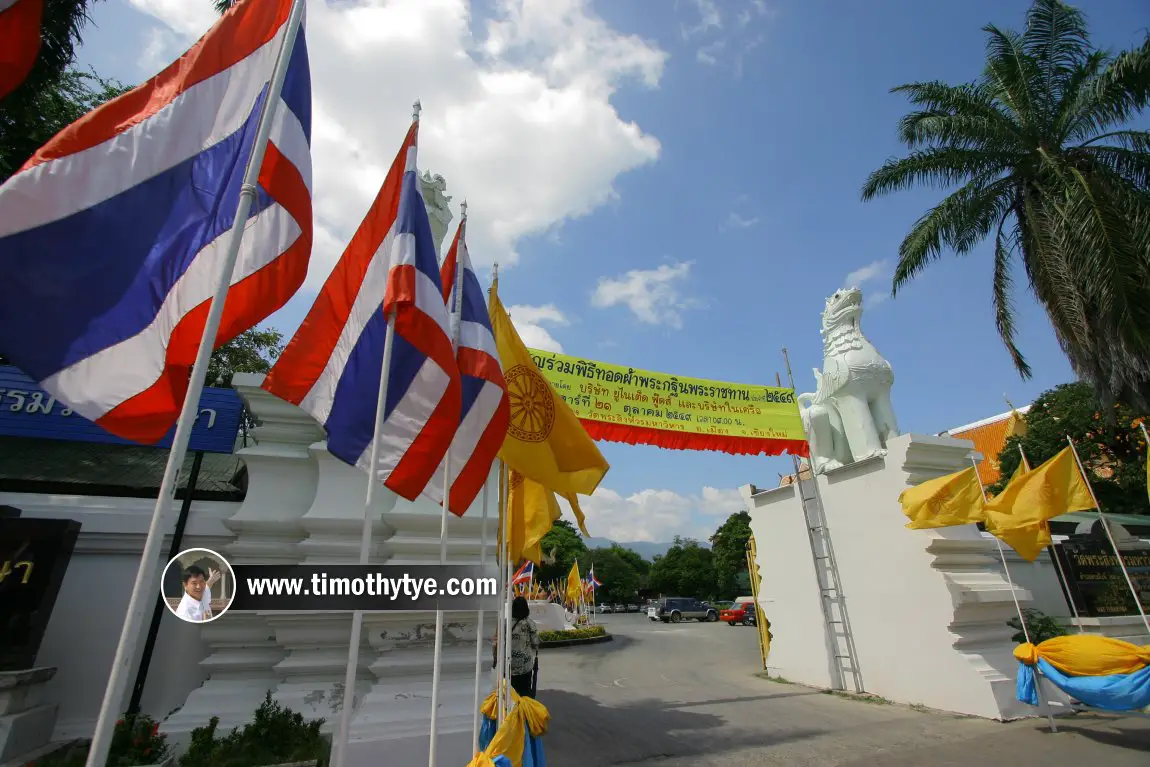 Entrance of Wat Phra Singh Woramahawihan
Entrance of Wat Phra Singh Woramahawihan (24 October, 2006)

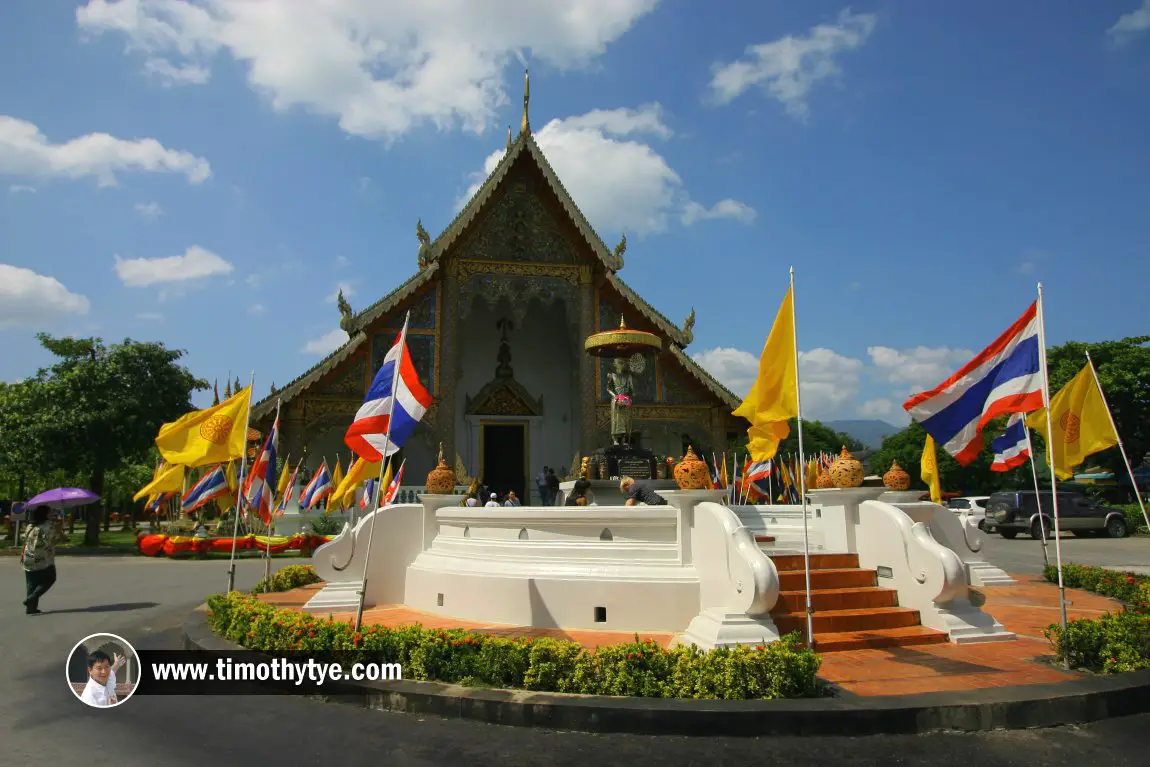 Roundabout in front of the Viharn Luang of Wat Phra Singh Woramahawihan
Roundabout in front of the Viharn Luang of Wat Phra Singh Woramahawihan (24 October, 2006)

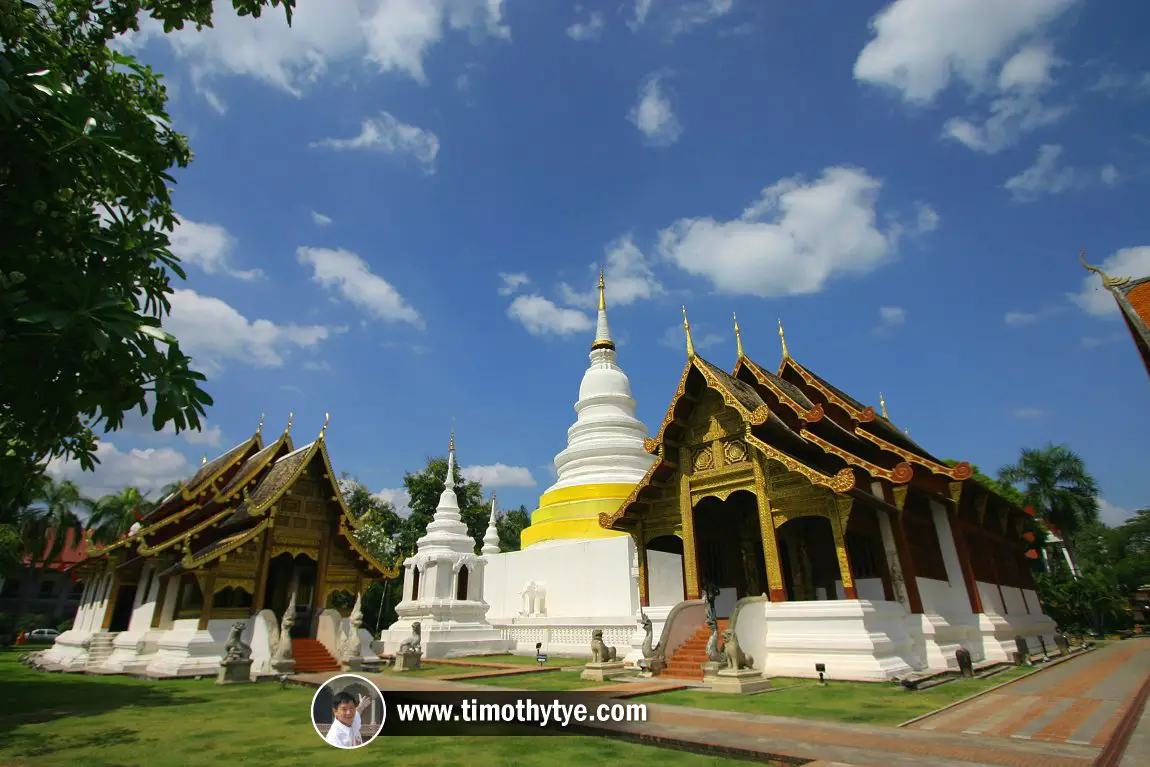 Viharn Lai Kham (left), the stupa (centre) and the ubosot of Wat Phra Singh Woramahawihan
Viharn Lai Kham (left), the stupa (centre) and the ubosot of Wat Phra Singh Woramahawihan (24 October, 2006)

 View of the stupa (left), the ubosot (centre) and Viharn Luang (right) of Wat Phra Singh Woramahawihan
View of the stupa (left), the ubosot (centre) and Viharn Luang (right) of Wat Phra Singh Woramahawihan (24 October, 2006)

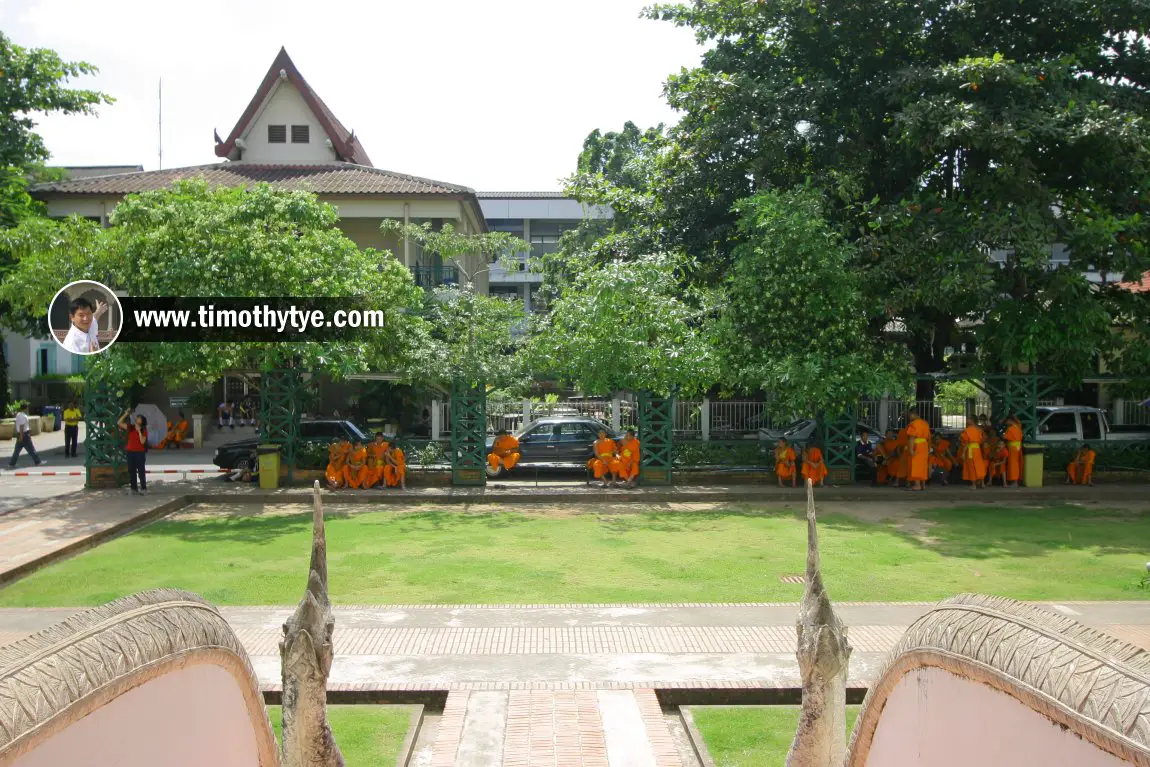 View of novice monks at recess, from the ubosot of Wat Phra Singh Woramahawihan
View of novice monks at recess, from the ubosot of Wat Phra Singh Woramahawihan (24 October, 2006)

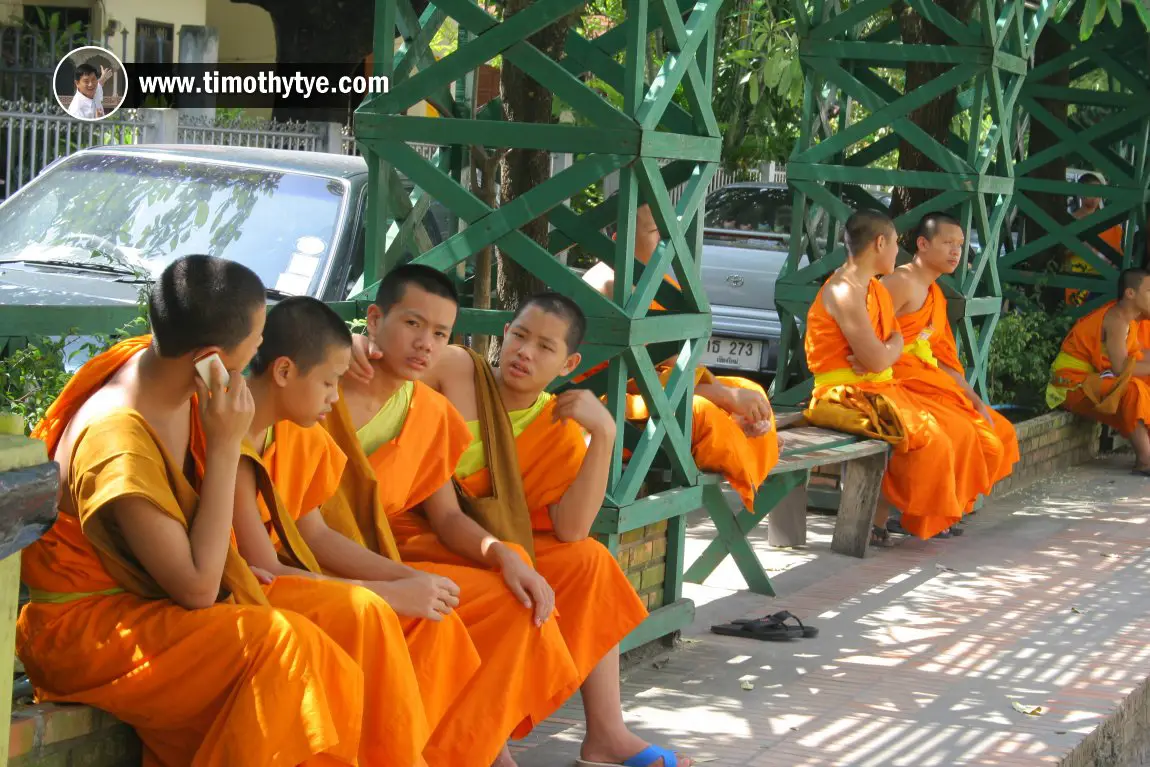 Novice monks at recess at Wat Phra Singh Woramahawihan
Novice monks at recess at Wat Phra Singh Woramahawihan (24 October, 2006)

[an error occurred while processing this directive]
Viharn Luang
Viharn Luang is the principal viharn of Wat Phra Singh. Built in 1925 to replace an earlier
viharn, it is huge, but quite plain. There is a big seated Buddha statue inside.
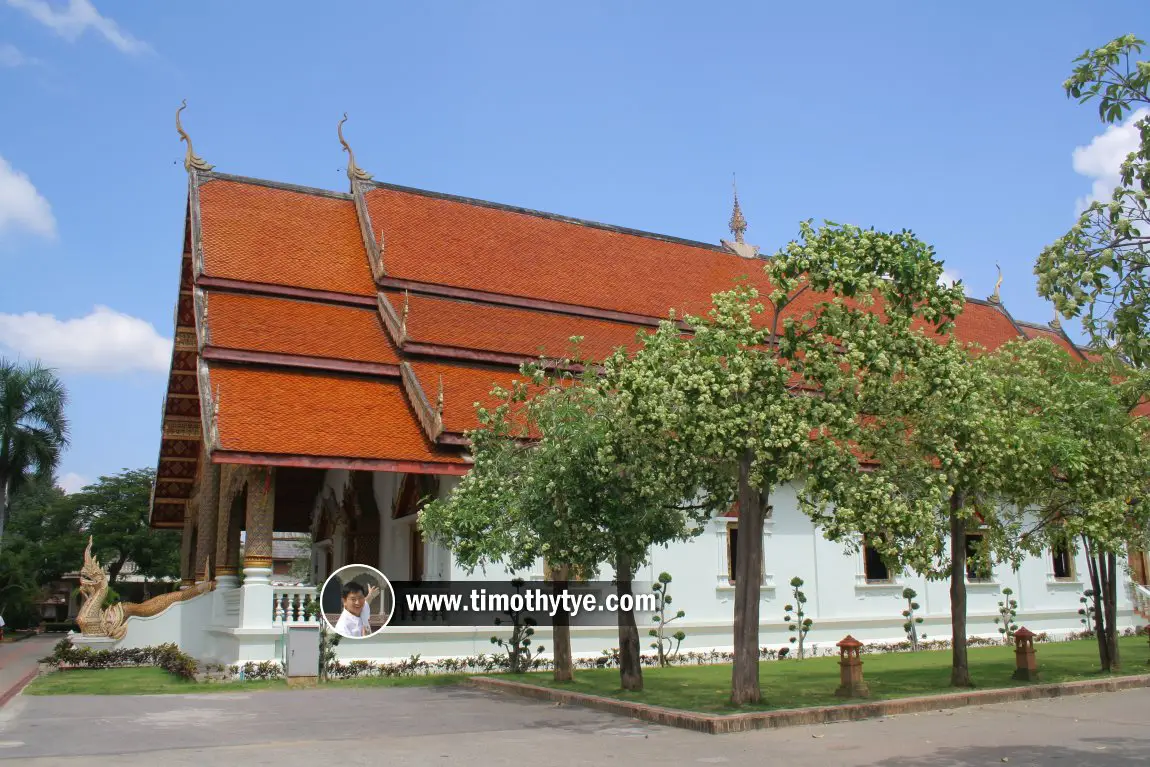 Viharn Luang, Wat Phra Singh Woramahawihan
Viharn Luang, Wat Phra Singh Woramahawihan (24 October, 2006)

 Interior of the Viharn Luang, Wat Phra Singh Woramahawihan
Interior of the Viharn Luang, Wat Phra Singh Woramahawihan (24 October, 2006)

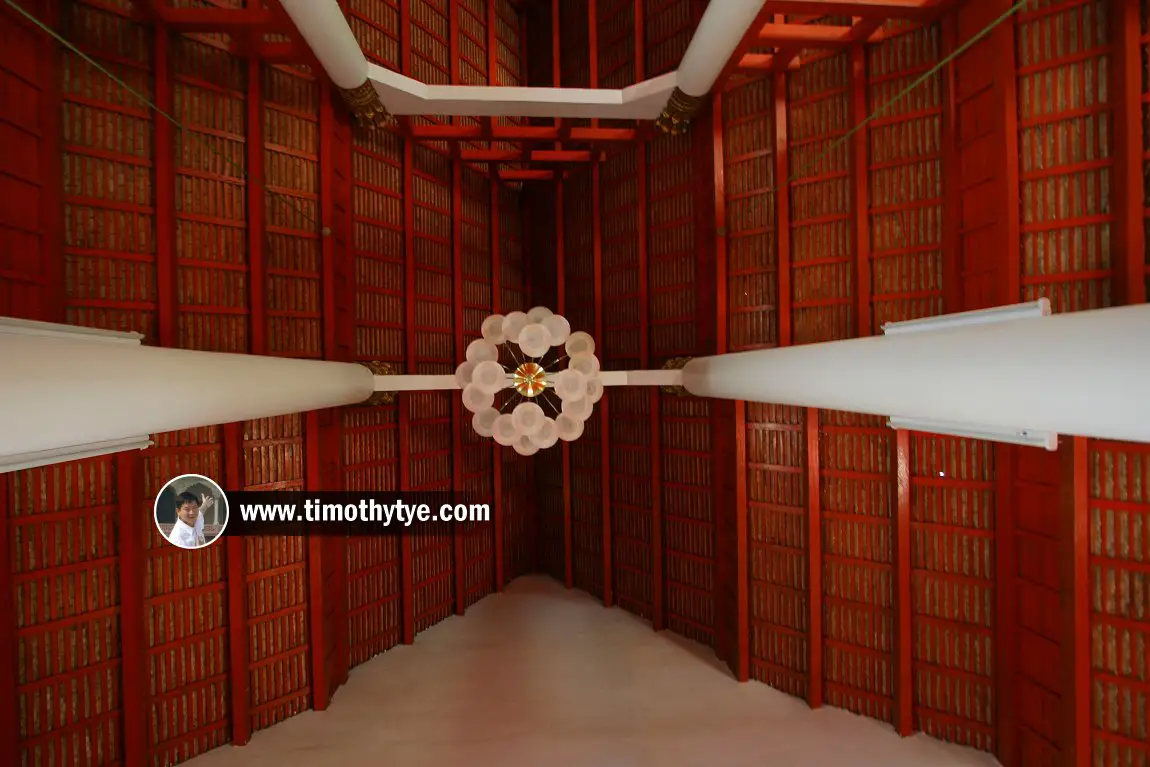 View of the ceiling of Viharn Luang, Wat Phra Singh Woramahawihan
View of the ceiling of Viharn Luang, Wat Phra Singh Woramahawihan (24 October, 2006)

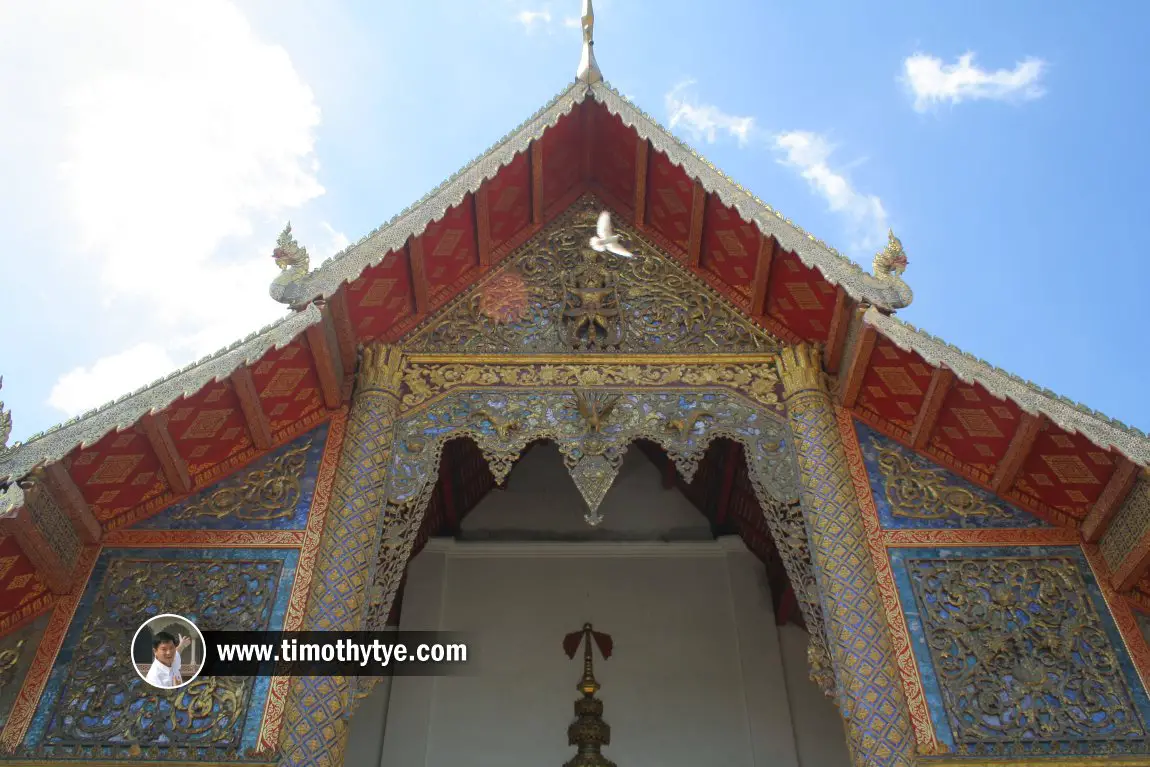 Gable of Viharn Luang, Wat Phra Singh Woramahawihan
Gable of Viharn Luang, Wat Phra Singh Woramahawihan (24 October, 2006)

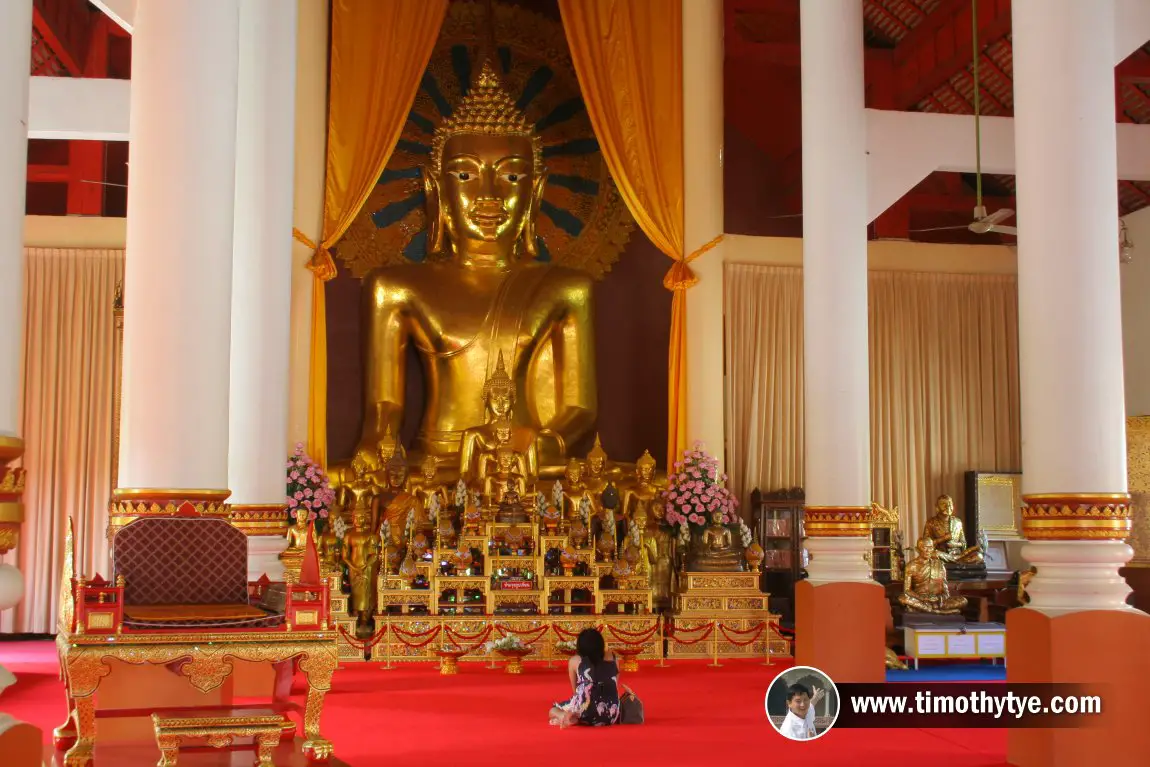 Main Buddha image, with smaller images at its front, in Viharn Luang
Main Buddha image, with smaller images at its front, in Viharn Luang (24 October, 2006)

 Mural on the leaf of the door of Viharn Luang
Mural on the leaf of the door of Viharn Luang (24 October, 2006)

Ho Trai, also called Hall of Phra Tripitaka
The
ho trai or scripture repository or Wat Phra Singh Woramahawihan is said to be one of the most exquisite examples of Lanna architecture. It was built in 1497, under King Tilokaraj, and was restored in 1867 under Chao Kawiroros Suriyawong, and again in 1926, during the visit of King Rama VII.The
ho trai is is wooden structure on a brick base, with a staircase flanked by
naga-makara leading up to it. The whitewashed base of the
ho trai has windows, with reliefs of
thewada, or male angels, in the between. These stand above a frieze that is intricately ornamented. On the structure's ridgepole are swan finials.
The Ho Trai is built to store the Dhamma, the Buddhist holy manuscripts and palm-leaf scriptures.
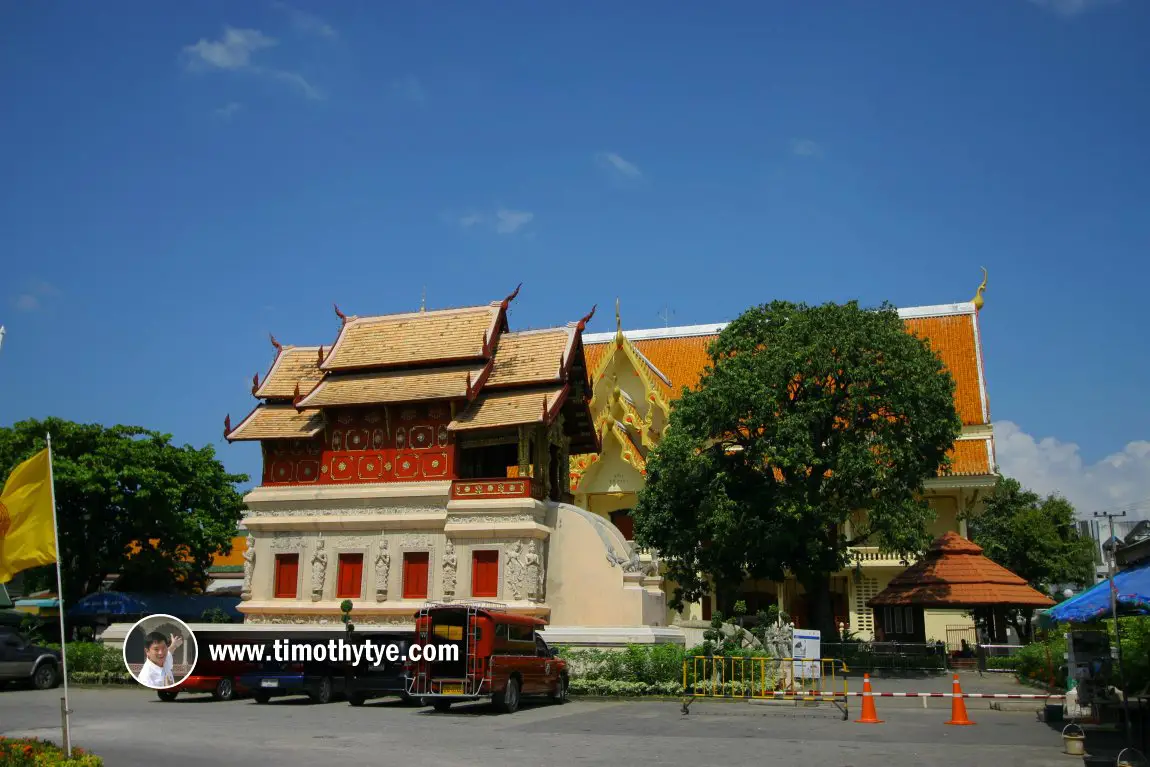 View of the ho trai or scripture repository of Wat Phra Singh Woramahawihan
View of the ho trai or scripture repository of Wat Phra Singh Woramahawihan (24 October, 2006)

 Ho Trai of Wat Phra Singh Woramahawihan
Ho Trai of Wat Phra Singh Woramahawihan (24 October, 2006)

Viharn Lai Kham
This is regarded as one of the finest buildings in the Wat Phra Singh complex. It was built in 1345 and renovated in the early 19th century. The generously gilded building - lai kham means "patterned in gold" - is covered by a two-tier roof, a third tier of the roof shelters the portico.
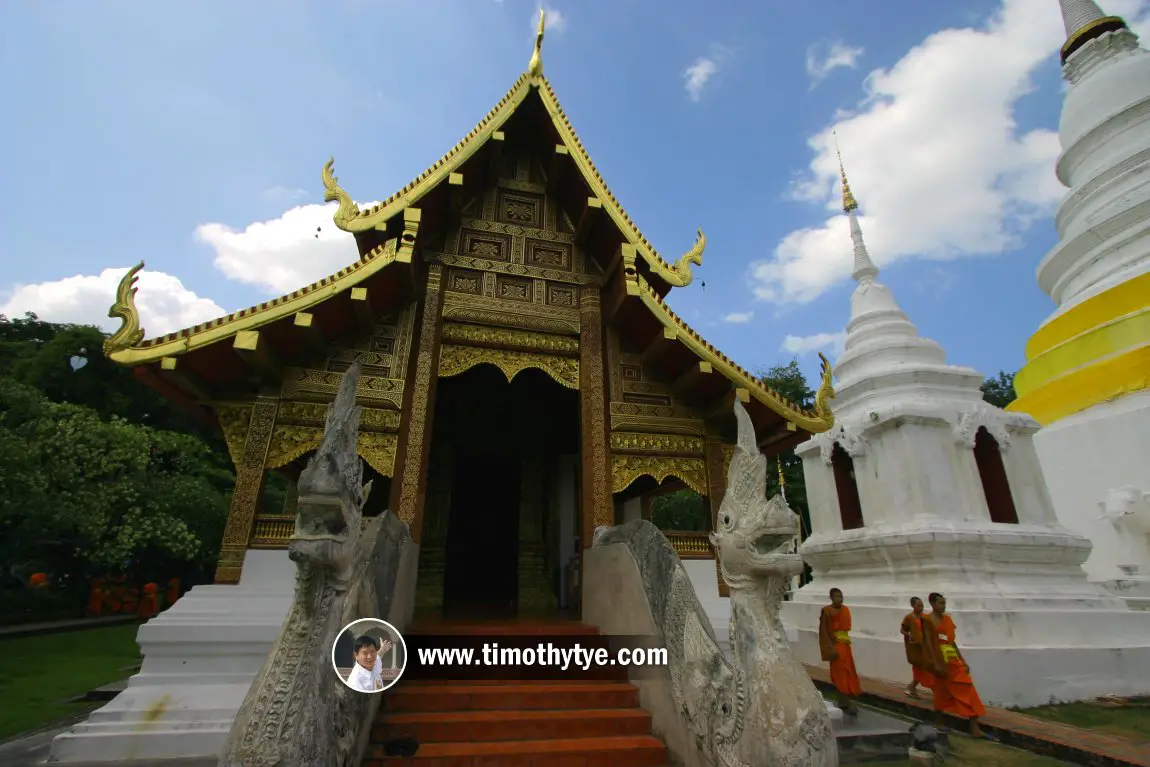 The front of Viharn Lai Kham.
The front of Viharn Lai Kham. (24 October, 2006)

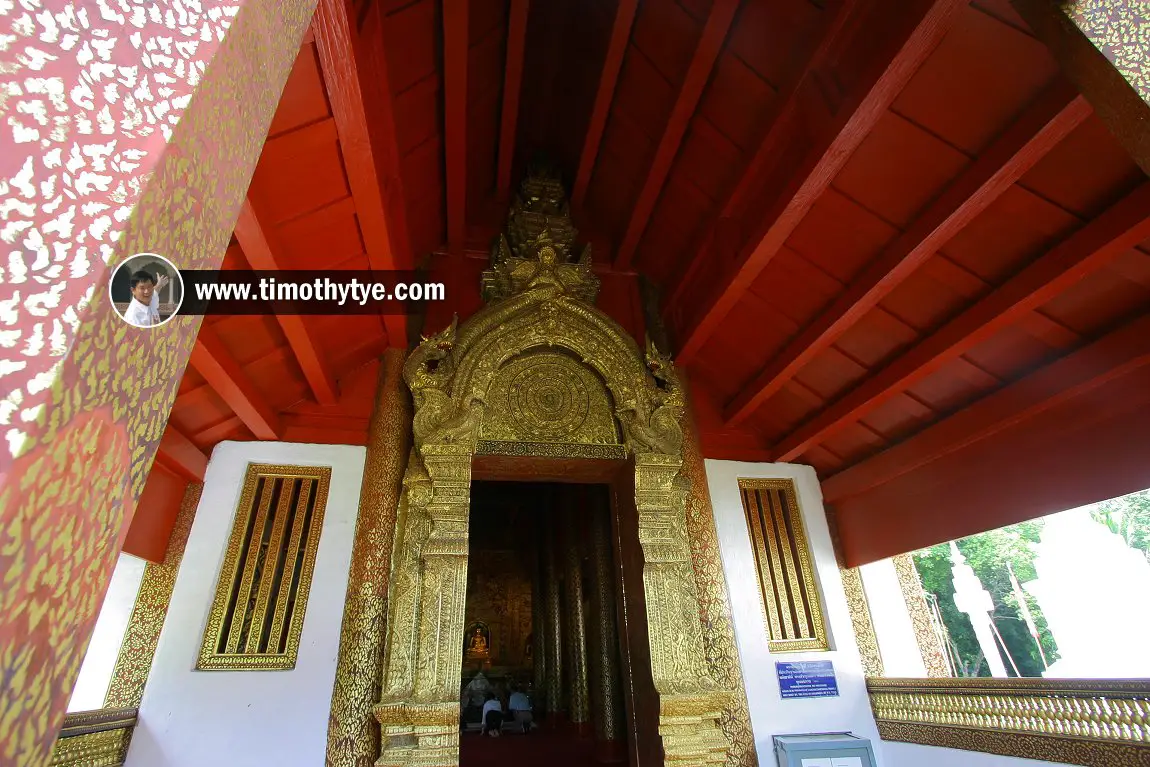 The portico of Viharn Lai Kham.
The portico of Viharn Lai Kham. (24 October, 2006)

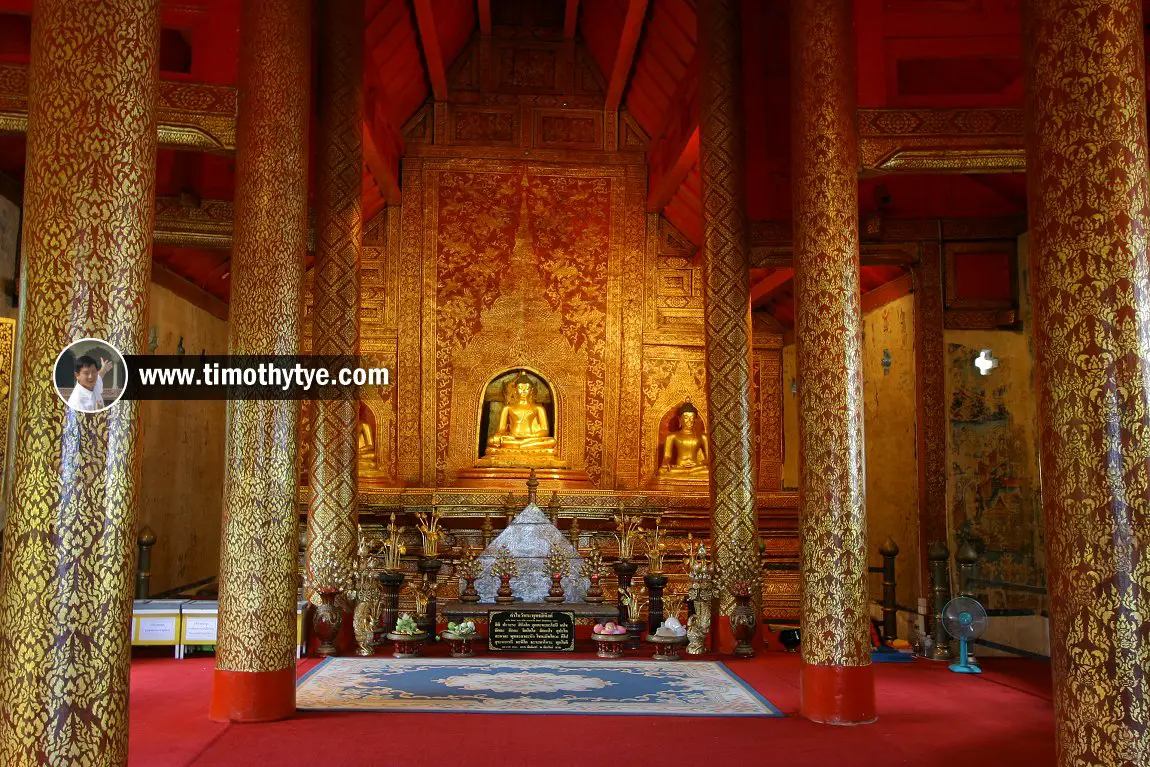 The interior of Viharn Lai Kham with the Phra Sihing Buddha.
The interior of Viharn Lai Kham with the Phra Sihing Buddha. (24 October, 2006)

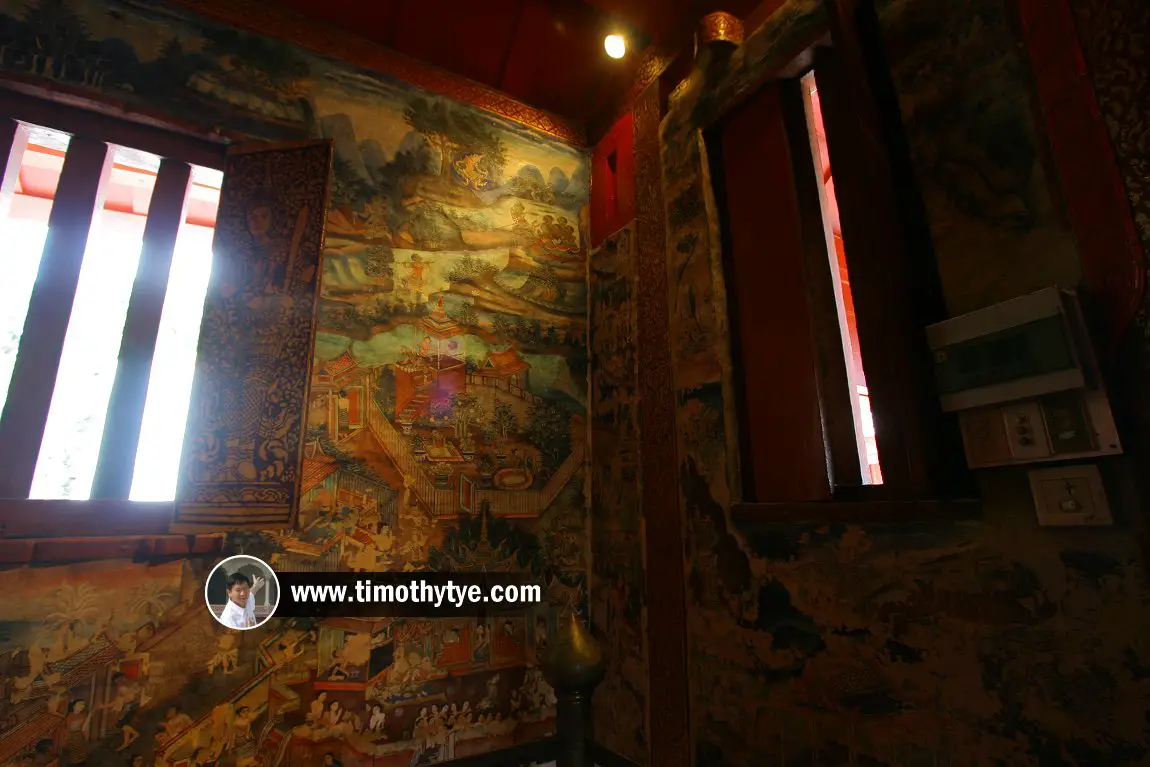 Murals covering the walls of Viharn Lai Kham were painted in the second half of the 19th century, and is regarded as among the finest examples of Lanna mural art.
Murals covering the walls of Viharn Lai Kham were painted in the second half of the 19th century, and is regarded as among the finest examples of Lanna mural art. (24 October, 2006)

[an error occurred while processing this directive]
Ubosot
The
ubosot or ordination hall for the monks, is located between the chedi and Viharn Luang. It was built in 1806. There are porticos on the north and south ends of the building. The south portico is particularly ornate, with gilded stucco pilasters.
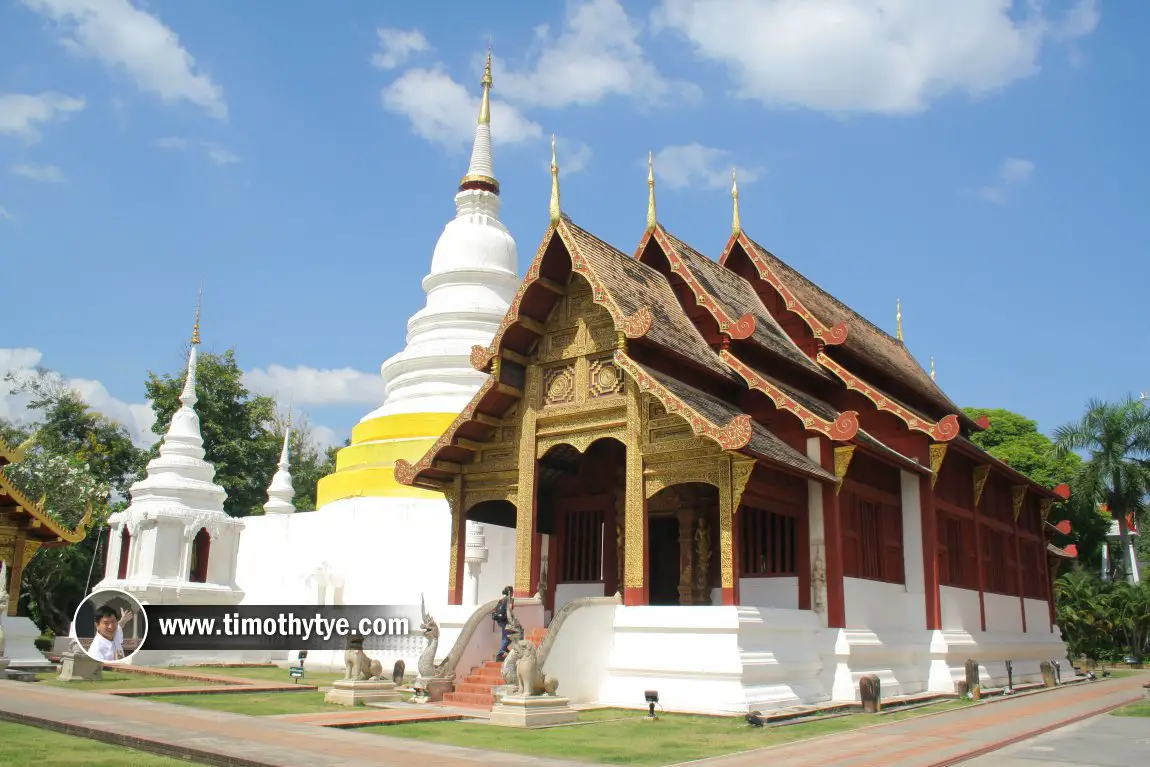 The ubosot of Wat Phra Singh Woramahawihan, with the chedi behind it
The ubosot of Wat Phra Singh Woramahawihan, with the chedi behind it (24 October, 2006)

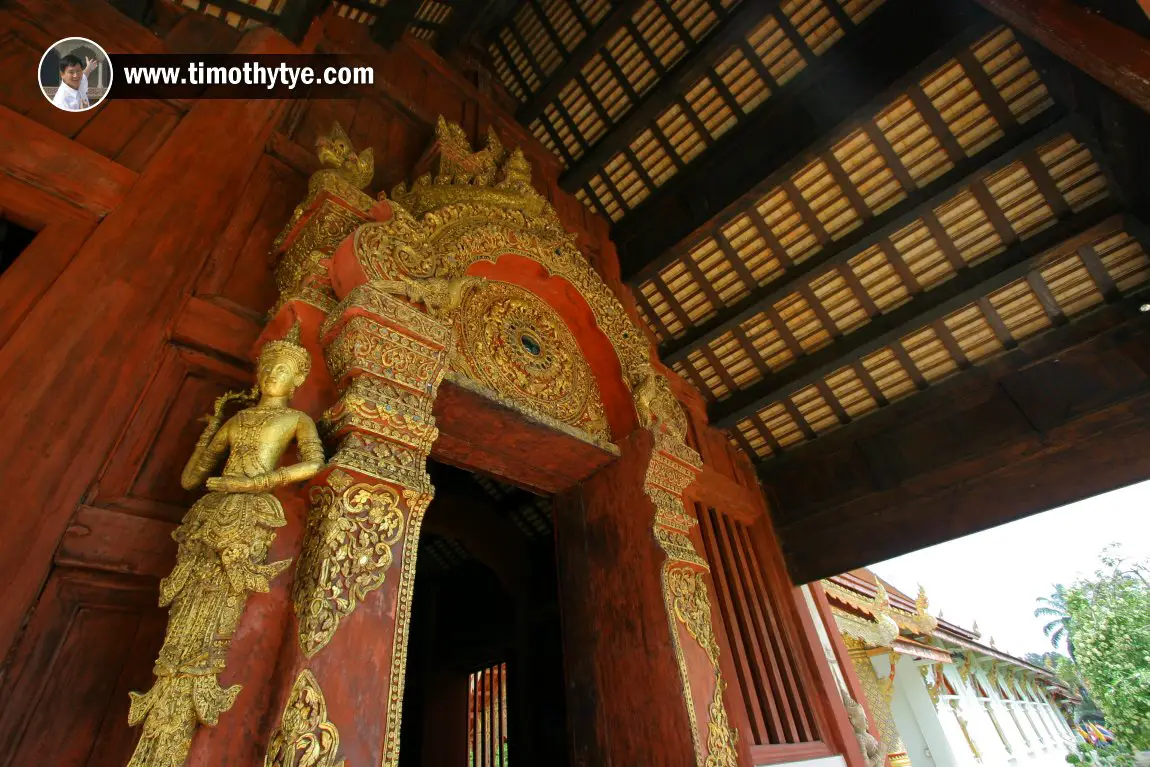 Entrance to the ubosot from its south portico has an ornate gilded stucco pilasters, with a naga-makara arch draped over a dharmachakra, or Wheel of the Law
Entrance to the ubosot from its south portico has an ornate gilded stucco pilasters, with a naga-makara arch draped over a dharmachakra, or Wheel of the Law (24 October, 2006)

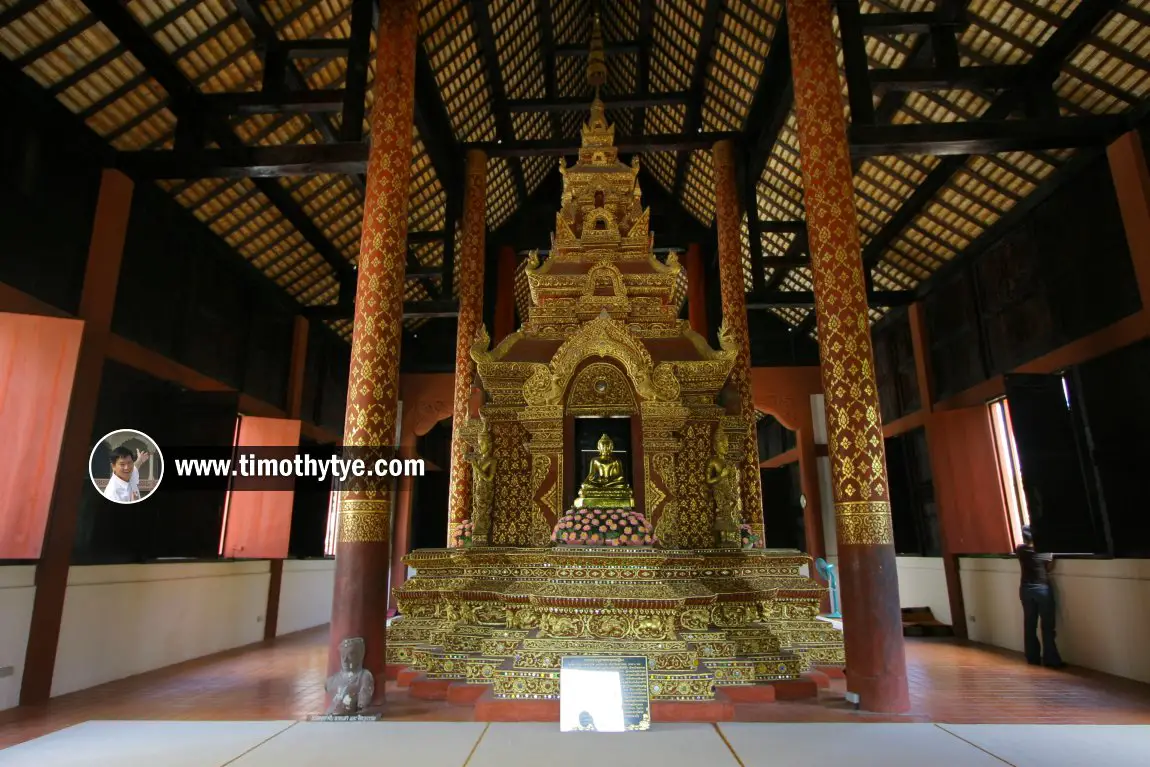 Interior of the ubosot.
Interior of the ubosot. (24 October, 2006)

[an error occurred while processing this directive]
Chedi
The Chedi of Wat Phra Singh dates back to 1345, and has been renovated and enlarged many times. The bell of the chedi sits on a plain square base, protruding out of which, on each side, is the forefront of an elephant sculpture. At the time of my visit, this was whitewashed, but it has since been entirely gilded. The chedi has three diminishing circular plinths, and ends in an umbrella spire.
 Chedi of Wat Phra Singh Woramahawihan
Chedi of Wat Phra Singh Woramahawihan (24 October, 2006)

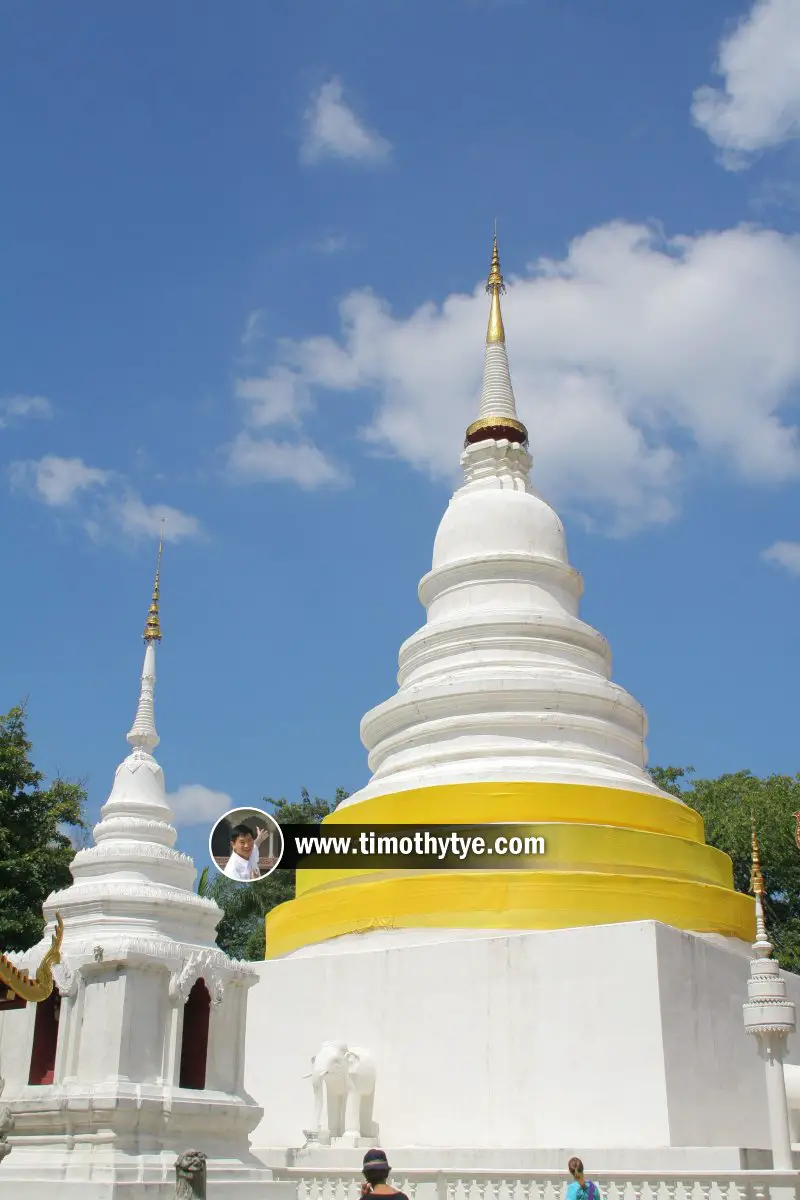 The Chedi of Wat Phra Singh Woramahawihan
The Chedi of Wat Phra Singh Woramahawihan (24 October, 2006)

 One of the minor stupas around the main Chedi of Wat Phra Singh Woramahawihan
One of the minor stupas around the main Chedi of Wat Phra Singh Woramahawihan (24 October, 2006)

Wat Phra Singh on Google Street View
Wat Phra Singh (Mar 2018)
 My wife (then girlfriend) Chooi Yoke and I in front of the ubosot of Wat Phra Singh Woramahawihan.
My wife (then girlfriend) Chooi Yoke and I in front of the ubosot of Wat Phra Singh Woramahawihan. (24 October, 2006)

Wat Phra Singh is  on the map of Chiang Mai
on the map of Chiang Mai
[an error occurred while processing this directive]
 Map of Roads in Penang
Map of Roads in Penang
Looking for information on Penang? Use this
Map of Roads in Penang to zoom in on information about Penang, brought to you road by road.
Disclaimer
Please use the information on this page as guidance only. The author endeavours to update the information on this page from time to time, but regrets any inaccuracies if there be any.

Copyright ©
2003-2025 Timothy Tye. All Rights Reserved.

 Wat Phra Singh Woramahawihan, Chiang Mai (24 October, 2006)
Wat Phra Singh Woramahawihan, Chiang Mai (24 October, 2006)
 ), or Monastery of the Lion Buddha, is one of the major temples within the Old City quarters of Chiang Mai, Thailand. It is located at the western end of Rachadamnoen Road. Known simply as Wat Phra Singh, this monastery contains two of the finest extant Lanna buildings in the whole of Thailand. Also housed here are some exquisite mural paintings.
), or Monastery of the Lion Buddha, is one of the major temples within the Old City quarters of Chiang Mai, Thailand. It is located at the western end of Rachadamnoen Road. Known simply as Wat Phra Singh, this monastery contains two of the finest extant Lanna buildings in the whole of Thailand. Also housed here are some exquisite mural paintings. Entrance of Wat Phra Singh Woramahawihan (24 October, 2006)
Entrance of Wat Phra Singh Woramahawihan (24 October, 2006)
 Roundabout in front of the Viharn Luang of Wat Phra Singh Woramahawihan (24 October, 2006)
Roundabout in front of the Viharn Luang of Wat Phra Singh Woramahawihan (24 October, 2006)
 Viharn Lai Kham (left), the stupa (centre) and the ubosot of Wat Phra Singh Woramahawihan (24 October, 2006)
Viharn Lai Kham (left), the stupa (centre) and the ubosot of Wat Phra Singh Woramahawihan (24 October, 2006)
 View of the stupa (left), the ubosot (centre) and Viharn Luang (right) of Wat Phra Singh Woramahawihan (24 October, 2006)
View of the stupa (left), the ubosot (centre) and Viharn Luang (right) of Wat Phra Singh Woramahawihan (24 October, 2006)
 View of novice monks at recess, from the ubosot of Wat Phra Singh Woramahawihan (24 October, 2006)
View of novice monks at recess, from the ubosot of Wat Phra Singh Woramahawihan (24 October, 2006)
 Novice monks at recess at Wat Phra Singh Woramahawihan (24 October, 2006)
Novice monks at recess at Wat Phra Singh Woramahawihan (24 October, 2006)
 Viharn Luang, Wat Phra Singh Woramahawihan (24 October, 2006)
Viharn Luang, Wat Phra Singh Woramahawihan (24 October, 2006)
 Interior of the Viharn Luang, Wat Phra Singh Woramahawihan (24 October, 2006)
Interior of the Viharn Luang, Wat Phra Singh Woramahawihan (24 October, 2006)
 View of the ceiling of Viharn Luang, Wat Phra Singh Woramahawihan (24 October, 2006)
View of the ceiling of Viharn Luang, Wat Phra Singh Woramahawihan (24 October, 2006)
 Gable of Viharn Luang, Wat Phra Singh Woramahawihan (24 October, 2006)
Gable of Viharn Luang, Wat Phra Singh Woramahawihan (24 October, 2006)
 Main Buddha image, with smaller images at its front, in Viharn Luang (24 October, 2006)
Main Buddha image, with smaller images at its front, in Viharn Luang (24 October, 2006)
 Mural on the leaf of the door of Viharn Luang (24 October, 2006)
Mural on the leaf of the door of Viharn Luang (24 October, 2006)
 View of the ho trai or scripture repository of Wat Phra Singh Woramahawihan (24 October, 2006)
View of the ho trai or scripture repository of Wat Phra Singh Woramahawihan (24 October, 2006)
 Ho Trai of Wat Phra Singh Woramahawihan (24 October, 2006)
Ho Trai of Wat Phra Singh Woramahawihan (24 October, 2006)
 The front of Viharn Lai Kham. (24 October, 2006)
The front of Viharn Lai Kham. (24 October, 2006)
 The portico of Viharn Lai Kham. (24 October, 2006)
The portico of Viharn Lai Kham. (24 October, 2006)
 The interior of Viharn Lai Kham with the Phra Sihing Buddha. (24 October, 2006)
The interior of Viharn Lai Kham with the Phra Sihing Buddha. (24 October, 2006)
 Murals covering the walls of Viharn Lai Kham were painted in the second half of the 19th century, and is regarded as among the finest examples of Lanna mural art. (24 October, 2006)
Murals covering the walls of Viharn Lai Kham were painted in the second half of the 19th century, and is regarded as among the finest examples of Lanna mural art. (24 October, 2006) [an error occurred while processing this directive]
[an error occurred while processing this directive]
 The ubosot of Wat Phra Singh Woramahawihan, with the chedi behind it (24 October, 2006)
The ubosot of Wat Phra Singh Woramahawihan, with the chedi behind it (24 October, 2006)
 Entrance to the ubosot from its south portico has an ornate gilded stucco pilasters, with a naga-makara arch draped over a dharmachakra, or Wheel of the Law (24 October, 2006)
Entrance to the ubosot from its south portico has an ornate gilded stucco pilasters, with a naga-makara arch draped over a dharmachakra, or Wheel of the Law (24 October, 2006)
 Interior of the ubosot. (24 October, 2006)
Interior of the ubosot. (24 October, 2006) [an error occurred while processing this directive]
[an error occurred while processing this directive]
 Chedi of Wat Phra Singh Woramahawihan (24 October, 2006)
Chedi of Wat Phra Singh Woramahawihan (24 October, 2006)
 The Chedi of Wat Phra Singh Woramahawihan (24 October, 2006)
The Chedi of Wat Phra Singh Woramahawihan (24 October, 2006)
 One of the minor stupas around the main Chedi of Wat Phra Singh Woramahawihan (24 October, 2006)
One of the minor stupas around the main Chedi of Wat Phra Singh Woramahawihan (24 October, 2006)
 My wife (then girlfriend) Chooi Yoke and I in front of the ubosot of Wat Phra Singh Woramahawihan. (24 October, 2006)
My wife (then girlfriend) Chooi Yoke and I in front of the ubosot of Wat Phra Singh Woramahawihan. (24 October, 2006)
 on the map of Chiang Mai
on the map of Chiang Mai Latest updates on Penang Travel Tips
Latest updates on Penang Travel Tips Map of Roads in Penang
Map of Roads in Penang